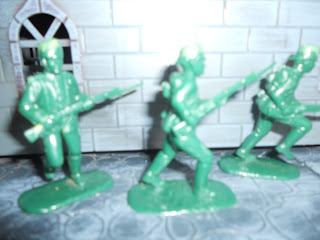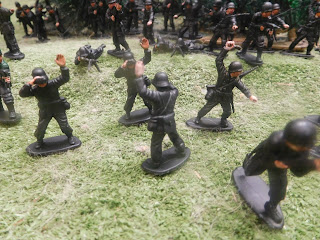Sepoys and figure sources.
This picture is from the Osprey book on the Indian Mutiny. When I was doing my history Honors degree I wrote a dissertation on fiction of the Indian Mutiny. The history tutors were a bit resistant to the use of fiction, but I won them over. One interesting fact about that war was it did not directly involve all India or all sepoys but was especially concentrated in Bengal. Native troops still played a key role in suppressing the rebellion.
The figure at left is an easy figure to represent because he is basically Napoleonic with Bell Topped shako. He is also virtually identical to the BMC Mexican soldier. All that is required is to cut the peak away from the headgear. I'm not one hundred percent sure but I think the shoulder rolls were for flank companies so can be omitted.
The trousers could probably also be painted white instead of dark blue as I think white was regarded as for the hot season. The other thing is to paint the white lace across the chest and on the jacket cuffs.
This style could be used for mutineers as well as loyal troops. I read somewhere that mutineers still went into battle flying their usual British derived flags. I'm not sure if that was just the regimental flag but also the Union Jack flag!
The sitting figure is more problematical but could be converted from Sudan Dervish figures. To convert from Napoleonics would involve carving down shakoes, trimming the bottom of the legs and building up the pants with putty.
Other mutineers wore less and there is a Britains bare-chested Detail Arab who fits the picture. Some of the Armies in Plastic Sudan War figures could also work.
The cavalryman is fairly straight forward and would be easy to convert.










I had a history Professor William McNeill who wrote Rise of the West and many other works who in his syllabus included works of historical fiction and thought they were an excellent way to get a feel for a period. Nice post.
ReplyDelete